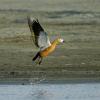Broad, long beak diagnostic. Male: metallic-green head and neck; in flight, dark head, back-centre, rump and uppertail-coverts contrast with white of back and tail; also, dull-blue upperwing-coverts against dark flight feathers; metallic-green speculum and white wing bar; in overhead flight, dark head, thick white neck, dark chestnut belly and flanks. Female: mottled brown, but blue-grey shoulders (wing-coverts) and dull green speculum distinctive. Pairs or small flocks, often amidst other ducks; swims slowly, with the beak held very close to water; sometimes up-ends.
- Browse
- Gallery
- Checklists
- Topography
- Glossary
- Bibliography
- Feedback
- About Us











